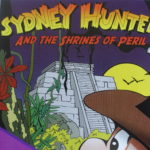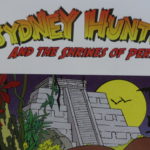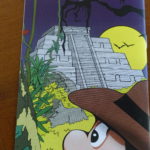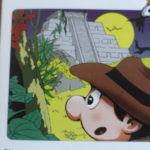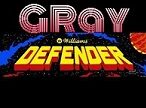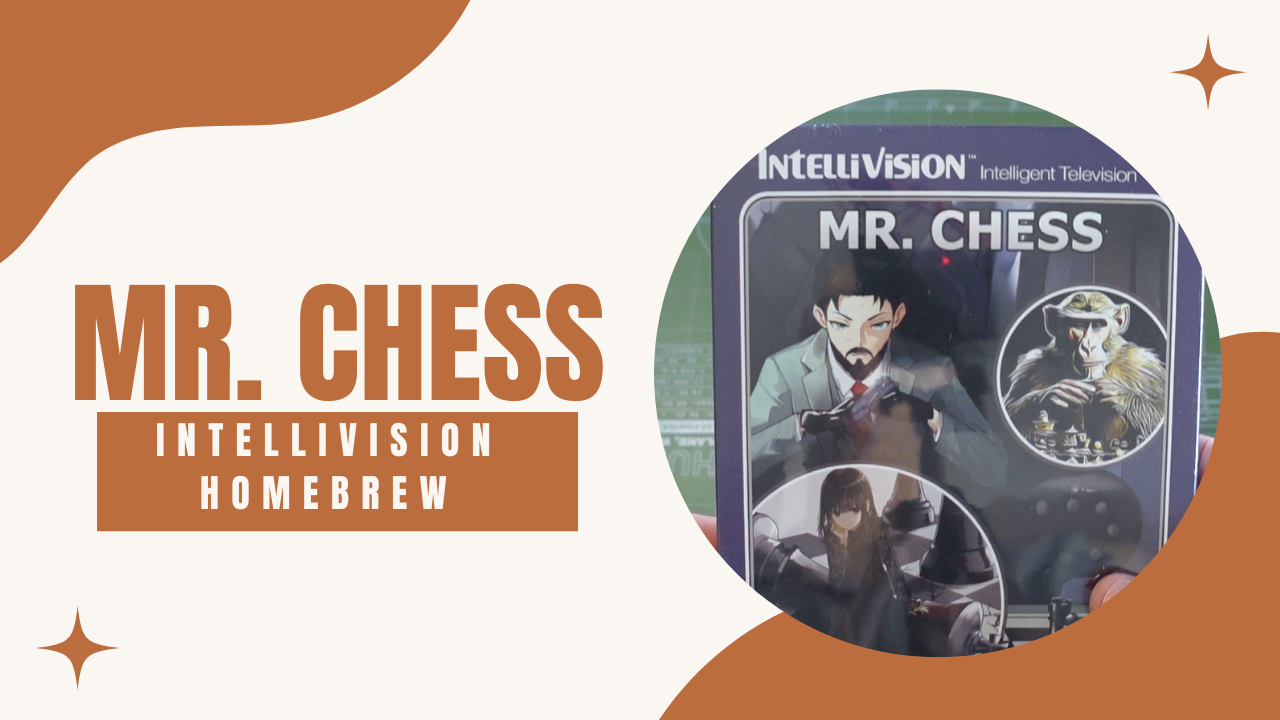Sydney Hunter and the Shrines of Peril Review
“Sydney Hunter and the Shrines of Peril” is a homebrew game for the Intellivision released by Collectorvision in July 2014.
In it, you play as the famous explorer “Sydney Hunter” and are exploring a variety of environments while trying to make your way to a hidden Mayan temple. At first look, it sort of reminds me of Montezuma’s Revenge for the Atari 2600. It was actually inspired by the game “Smurfs Rescue” for the Colecovision which was never ported to the Intellivision.
In this game, quoting from the manual, you have to “dodge the spooky hawks, bats, and spiders along the way to the hidden Mayan temple. Can you find the way to the treasure?”
When you first power on the game you are presented with the initial and fairly basic title screen. It has the games name graphically displayed with a nice yellow image of “Sydney Hunter”, followed by a torch laying against a human skull. From here pressing any button on the controller will initiate the start of the game. Sydney Hunter is a single-player game.
When the game begins you will notice your lives remaining on the top left and next to it your seven-digit score, both displayed in white. Just underneath your score is the time indicator with the word “Time:” displayed in red with an orange progress bar. The manual also calls this the energy level indicator, but since it says time on the screen, I’ll refer to it that way. Should your time run out, Sydney Hunter will fall down costing you a life. You start the game with four lives. The time bar will be replenished whenever Sydney Hunter enters into a NEW land. Going backward to the previous screen will not renew it. The only other way to reset it is to let it run all the way out. You will lose a life but start with your time bar refilled. While on this topic, the worst time to lose a life is when your time is extremely low. When you start with a new Sydney Hunter, he will still have low energy and will die quicklyIn this game, there are four main screens or lands to be conquered. The “forest”, the “field”, the “cavern” and the “Mayan temple”.
“The Forest”
You start the game in the forest which is represented by the black trees in the background. There is a musical tune playing as you make your way. This tune changes each time you enter a new land. Sometimes in the forest, you will find a hissing snake on the right side.
Controls:
You control Sydney Hunter using the Intellivision controller disc. Pressing left or right will move him in that direction. Pressing down will cause him to duck. Now, the manual states pressing the upper buttons will make a big jump and the lower buttons will make a small jump. However, on my Intellivision the upper buttons do nothing. Instead pressing the lower button on the right side of the controller will make a big jump and the lower left button will make a small jump.
You cannot let Sydney Hunter touch any of the baddies; the snake, hawk, bat, or spider, really you cannot let him touch anything; walls tombstones, skulls, skeleton arms, the exception being grabbing the diamonds. Hint: You must do the big jump for most obstacles in the game. You get more points for completing a small jump over the spiders and onto and over the ledges.
“The Field”
After successfully making it out of the “forest” you enter the “field”. This screen is a little spooky with the cemetery displayed in the background and the half-moon crescent. There is a ledge that must be negotiated. Beware, falling off the ledge will cost you a life. In the early levels the ledge is the only challenge presented, but in later levels, the placement of the ledge moves, and a few more obstacles may be thrown in such as a random skull or a headstone. You may also find yourself having to dodge those pesky hawks.
“The Caverns”
Once you leave the “field”, you enter the caverns. This area is interesting since you must jump up or down ledges. They have what looks like the skeleton of a bull right next to the ledges which you have to be careful not to jump onto. Doing so will cost you a life. In the early levels, there is only one ledge to negotiate and no bats. In later levels, there are two or three ledges and a bat to worry about. The placement of the ledges can move from level to level and the spacing between them can reduce. This means you may have to accurately plan your jumps In-between the skulls and you may have to do a small jump rather than the big jump, all of which takes skill!
You will repeat going through these lands a few times with different challenges thrown at you before making it into the final land area, the Mayan temple.
Mayan Temple – Spider screen
When you first make it into the Mayan temple, you will notice you are now standing on yellow bricks with dark stone walls in the background. Covering some of the stones on the far right is a huge spider web. As you move closer a spider might pop out and have to be avoided. One thing that jumps out at me on this screen is within the spider web I keep noticing the number four. Is that some sort of a clue? I tried jumping four times and jumping the spider four times to no avail.
Mayan Temple – Diamond screen
In the second Mayan screen you have to climb what looks like an ancient tomb in order to capture the diamonds at the top. I really like the graphics on this screen which are giant stone figures. In order to get the diamonds, you must jump on top of two stone heads in two separate jumps. Hint: The first jump can easily be done from a stationary position close to the stone head. For me, the second jump was easier to make successfully if running toward the second stone head while jumping. In my testing, I died if I jumped from a stationary position.
Scoring
As per the game’s manual, the scoring is as follows. Jumping snakes will get you 200 points. Jumping mounds, bluffs, skulls and tombstones is worth 100-200. Jumping the bat in the cavern, 200-300. Jumping the spider, 100-200, although, during gameplay, I believe jumping the spider with a small jump awarded you 300 points. Jumping onto the statue in the temple is worth 3,000 points, the first time done successfully, otherwise, 100 points each is awarded for jumping onto the stone heads. Collecting the diamond treasure gets you 10,000 points. You are also awarded bonus points based on your remaining time, which amounts to 100 points for each remaining slice of time you have.
For Every 25,000 points scored you are awarded a spare “Sydney Hunter”.
Strategy
Try to learn the distance you jump and pay attention to where you land. This becomes important in the later levels. You can duck underneath the hawk many times, but sometimes it will still get you, so practice jumping it. The next tip is nearly cheating. If you enter a new screen and it looks too difficult, you can quickly go back to the previous screen then re-enter the new screen again, and the map will randomly shift things around, perhaps making it easier to complete. Also related to this; if you memorize which screen the new land will appear on, you can do a scoring hack where for example, you keep jumping the snake for a few hundred points a pop until your time runs low, before moving on to the next screen and having your time replenished.
Graphics
Overall I like the graphics in “Sydney Hunter and the Shrines of Peril”. The imagery gets its point across, evoking a sense of spookiness and scary environments. Sydney Hunter himself is a nice multi-colored and animated sprite. You can tell he is wearing a hat and wearing multi-colored clothing. You can even tell he is wearing blue shoes. Really nicely detailed. The background images although repetitive on the forest and field screens are nicely detailed as is the grass. The cavern maps look great with the stalagmites. The Mayan temple imagery is awesome.
Sound
I like the simple music in the game and appreciate that it changes when you enter into a new land area. This helps keep it interesting. The various sound effects in the game include a sound for moving Sydney Hunter, a separate sound for jumping. The flying hawk and bats each have their own unique sounds. A separate tune for capturing the diamond and a sound effect for dying. Disappointingly there is no tune or sound effect for when the game ends and there is no title screen music.
World Record
I was unable to locate any official World Records for this game as of this review.
Packaging
The boxed copy of Sydney Hunter and the Shrines of Peril looks terrific. It’s a cartoonish rendition of what Sydney Hunter looks like while discovering the Mayan temple as he peeks through the brush. It’s colorful and incorporates many of the game’s levels all in one image. The same image is also used on the games printed manual. If you turn over the manual to the backside you’ll get a nice treat. The full image is printed encompassing all the real estate on the back of the manual and it looks great.
Ports
Sydney Hunter has sort of becoming its own Mayan themed franchise. The “Shrines of Peril” is the second game released in this product line, the first being “Sydney Hunter and the Caverns of Death”, which was released on a number of systems but did not make it’s way to the Intellivision. The “Shrines of Peril” has been ported to Android mobile and the IOS port is in the works. I had the pleasure of meeting John Lester from Collectorvision a few years ago at the SoCal Retro gaming expo. The android port had just been completed and he was excited to tell me all about it.
The great thing about the mobile version is that both the sound and graphics are identical to the Intellivision version. I mean the graphics look pixel perfect. The controls take some getting used to. There are a few notable differences specific to mobile. I have been playing on Android version 1.10. The first difference you’ll notice on mobile, there is a “round” indicator displayed on the top right. You cannot move back to the previous screens. The game plays slightly faster. Another quick example is there are a few scoring differences like no 10,000 point bonus for grabbing the diamonds. Jumping up to the treasure can be done fairly easily from a stationary position.
Easter Eggs
On page six of the manual in a section called “the fun of discovery”, it hints at something, possibly an Easter Egg. How would you interpret this statement: “You will find that this cartridge is full of special features that made Sydney Hunter and the Shrine of Peril exciting every time you play. Experiment with different techniques and enjoy the game!” That statement intrigued me although I have yet to uncover any hidden secrets or messages. It might just be a tease.
Conclusion
“Sydney Hunter and the Shrines of Peril” can be a difficult game to learn to play and master, even though the gameplay elements are so simple, move left, right, or jump. I have read a few complaints from people bemoaning how difficult it is. Yes, it is unforgiving. If you barely touch a wall or anything for that matter you will lose a life. If you jump up to a ledge from the wrong angle you die. If you move too close to a ledge you die. If you run out of time you die. However, once you learn these things, you find that It’s all just part of what makes this game so fun to play. The more I play, the further rounds I have been able to complete. I am also still trying to discover the secrets of this game. This is my first delve into the Sydney Hunter universe and I am looking forward to playing more of these games.
Recommended.
Youtube Description:
This is my review of Sydney Hunter and the Shrines of Peril for the Intellivision.
Collectorvision website:
http://collectorvision.com/
Youtube Original Post Date: 02/23/2018

